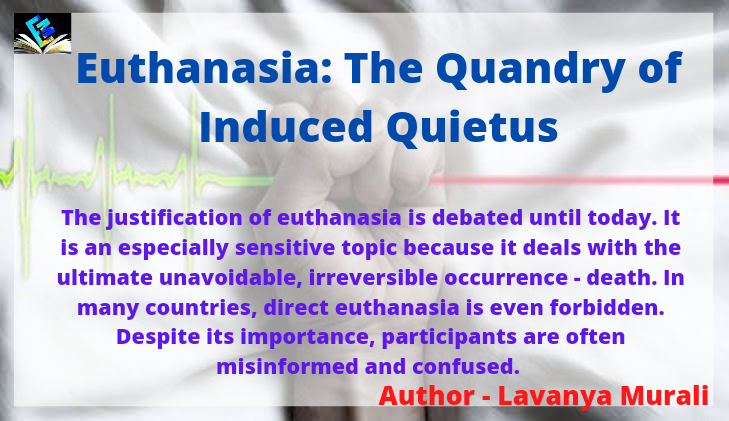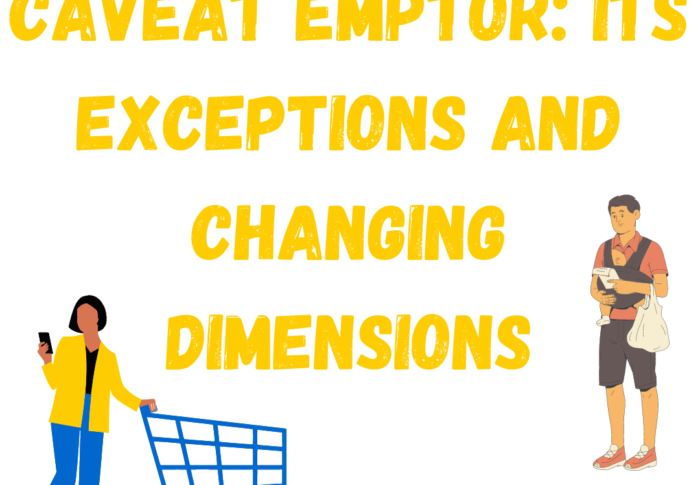
Euthanasia: The Quandry of Induced Quietus
Author: Lavanya Murali
For over 2500 years doctors around the world have sworn by the Hippocratic Oath and ethically bind them to treat the sick to the best of their abilities and never intentionally cause harm to their patients. The problem is, how does euthanasia fit within these ethical boundaries? The ethics surrounding euthanasia have been put under the microscope several times. The justification of this practice is debated until today. It is an especially sensitive topic because it deals with the ultimate unavoidable, irreversible occurrence – death. In many countries, direct euthanasia is even forbidden. Despite its importance, participants are often misinformed and confused.
Euthanasia – Types
Active euthanasia is the act of introducing a toxin or a toxic dose of a substance in order to induce death in a person. Passive euthanasia is the act of withholding or limiting life-sustaining treatments. When most people think of euthanasia, they think of the active type. Sometimes, the distinction between passive euthanasia and palliative care becomes blurry. Since palliative care involves keeping a patient as comfortable as possible until the end of their life, a palliative care doctor might advise someone who is approaching death to stop taking certain medications if they cause unpleasant side effects, or they may allow someone to take a much higher dose of a medication to treat severe pain. This is standard in palliative care and is generally not considered euthanasia.
Consent In Euthanasia
In some places, voluntary euthanasia is considered legal. Voluntary euthanasia is when the individual makes a conscious decision to end their life with assistance. Patients who are extremely distressed, and facing terminal, debilitating illnesses may feel that death is preferable to life. Non-voluntary euthanasia is when someone else consents to the person’s assisted demise. Usually, this is done by a close family member, since the patients themselves may be unresponsive. A survey done in 2016 found that in countries where it is legal, euthanasia accounts for 0.3 – 4.6% of deaths.
Aspect Of Right To Die
Often in debates about euthanasia, the “right to die” argument is brought up. This argument proposed the right to bring death upon oneself by choice. Death can be delayed or accelerated but never avoided. It is an inevitable end to existence, and cannot be thwarted. The right to die, therefore, is a contradiction. Rights connote an obligation on the rest of society. Therefore, where the right to die exists, it would mean some agency in society must inflict death on others.
This must be distinguished from the right to choose when to die, or the right to be allowed to die. This connotes the choice to refuse treatment, and this arises from their right to not be touched or treated without consent, exercising their right to remain un-violated.
Suicide
There has been the argument that the decriminalisation of suicide justifies assisted suicide. However, the fundamental difference between suicide and assisted suicide must be understood. Suicide is an act carried out by an individual usually in despair. Psychiatrists strive to prevent this and emergency workers strive to save those who attempt suicide. It is generally seen as the manifestation of inadequately treated mental illness. In extreme cases, suicide can even be thought of as the result of criminal negligence.
Assisted Suicide – Euthanasia
Assisted suicide, or euthanasia, is a social act involving licensed medical personnel. It deviates from the argument of preservation of life in the sense that the state and society should accept a person’s judgement that their lives need not be continued. It is said that such drastic measures are not required in this day and age, as people need not live in excruciating pain and this improvement is owed to palliative care. This view, however, has several drawbacks to be considered.
Curating the best palliative care plan for an individual involves trial and error, with some consequent suffering in the process. Even the best care cannot relieve all the pain and suffering of the patient. Perhaps even more importantly, high-quality palliative care can bring outside effects such as nausea, incontinence, loss of awareness because of semi-permanent drowsiness, and so on. Palliative care is often described in a rosy comforting manner to show how it can transform the plight of suffering patients. According to those who have closely observed the effect of extended courses of treatment with drugs like morphine, this can often be misleading. For these reasons, many skilled palliative care specialists acknowledge that palliative care does not enable an easy death for every patient.
It is also difficult to determine whether the individual is competent to request assistance for suicide, since their mental state and physical state are not good, and they may never be able to form an enduring and voluntary judgement about being better off dead, rather than continuing to suffer from an illness. There can never be sufficient evidence to prove that a dying person’s request to put an end to their suffering sooner is enduring, competent and voluntary.
Legal Perspective
Further, the legalisation of voluntary euthanasia can lead to the legalisation of other types of euthanasia, particularly non-voluntary. Certain acts of non-voluntary euthanasia have the potential to be justified, for example, for those in persistent vegetative states who have never indicated their wishes about being helped to die, or for certain severely disabled infants for whom the outlook is hopeless.
It may be hard to understand this slope, because voluntary euthanasia is seen as accepting the autonomy of a person, and is hence psychologically easier to advocate and legalise. Studies carried out in the Netherlands in 1995, 2001, 2005, and 2010 have consistently shown, however, that no such slope exists, and there is no reason to fear the legalisation of non-voluntary euthanasia as a product of legalisation of voluntary euthanasia. These studies have shown that 60% of the terminally ill people who have been assisted to pass away have volunteered. Others were no longer competent, and these cases were not seen as non-voluntary since the advice of the family members and medical professionals were seen as substitute judgements.
Concluding Remarks
Euthanasia hence is a moral and ethical conundrum that can be viewed through many lenses, each providing a new problem. The ethical connotations and the subsequent consequences of the legalisation of this practice everywhere might, however, become an important, useful undertaking, which would provide people with the choice to end their suffering. To do this, however, this decision must be proved to be enduring, voluntary and the patient must be competent.
Mail us at info@edumound.com






